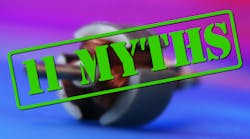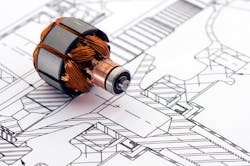The purpose of an electric motor is to convert electrical energy to mechanical energy in the form of rotational force. Just about anywhere that machinery is required to create movement, the chances are it probably contains an electric motor.
Motors come in various types, but the main differentiator lies in how the motor is powered (Fig. 1). With AC motors, power comes from an alternating source such as the AC mains, while DC motors take direct current from other sources like batteries. Aside from these two major distinctions, motors can either contain brushes or be brushless, and they may also have various numbers of phases and cooling mechanisms.
1. Motors are doomed because they’re inefficient.
This myth sits at the top of the list simply because it could not be further from the truth. As of 2019, it was estimated that over 300 million motors are in use all over the world—a figure that’s still growing at around 10% each year. By the year 2030, this number will have virtually doubled. To match the world’s growing appetite for electrical devices, consumers and manufacturers alike still have a strong demand for electric motors. Although the majority of motors are still highly inefficient, the situation can be greatly improved with motor drivers and controllers.
Research shows that around 45% of the world's electricity and 69% of all industrial energy is consumed by electric motors, gobbling up a total of almost 16 billion kWh. In comparison, energy-efficient LED lighting is responsible for just 19% of global electricity consumption. Working on the efficiency of motor drives presents a possible opportunity to save 1.8 billion kWh, which is the equivalent of around 250 nuclear reactors being decommissioned.
2. Brushed DC motors will be replaced by brushless DC motors.
The simple construction and ease of use of brushed DC motors make them difficult to displace. In comparison, the drawbacks of brushless DC (BLDC) motors are that they’re much more complex and difficult to drive. When the lower cost of front-end design, testing, and manufacturing is considered, along with their overall reliability, DC motors often come out as the more attractive option. However, in designs where electromagnetic interference is an issue, or where accuracy is more important than cost, BLDC motors are first choice.
3. All DC motors are basically the same.
There are many different types of DC motors on the market. BLDC motors and brushed DC motors have been discussed in the point above, but there’s another main type: The stepper motor, which provides output in distinctive steps depending on the pulse received (Fig. 2). Stepper motors are reliable and safe, but their torque diminishes at higher speeds. Also, there’s the reluctance motor, a low-cost induction-based motor that can run at constant high speeds for long periods of time once started.
4. DC motors are better than AC motors.
The true answer to which type of motor is better depends on a number of factors. While DC motors generally offer higher torque and generate less heat, the brushes will need replacing. And if you use a BLDC variety, it further increases system complexity. On the other hand, while AC motors are low on maintenance and require less power on startup, they do tend to be noisier and hotter. Other drawbacks include poor positioning control and lower starting torque.
5. AC and DC motors are very close in price.
The motor selection process will depend on variables such as application, cost, time to market, and the operating environment. The design engineer will then need to run through a series of questions, such as how the motor will be controlled, the positioning accuracy required, the physical size and mounting position, torque requirements, RPM requirements, and power source available. All of these factors determine the true cost of the motor—whether it’s an AC or DC motor is just one of them.
6. High-efficiency AC and DC motors save more money.
As a general rule of thumb, the more expensive the motor is, the more efficient it is, thereby saving operational costs in the long run. But although the most energy-efficient motors currently on the market are BLDCs, they’re also the most expensive to manufacture, drive, and control. One solution is to utilize the same method of driving BLDC motors for AC motors, thereby increasing efficiency but still keeping the overall motor system cost slightly lower than a full BLDC system.
7. BLDC motors are almost as efficient as brushed DC motors.
Every brushed DC motor features brushes. These electrical contacts, connected to the inner shaft via a commutator, rotate when the armature is electrified. As the name suggests, a BLDC motor doesn’t contain brushes. The coils are wound onto permanent magnets around the rotor, and the shaft spins through an electronic controller that works with a rotor position sensor. A BLDC motor can therefore be up to 90% more efficient because it doesn’t require power for the commutator or brushes.
8. AC motors are better because they don’t require conversion to DC.
AC motors are generally less expensive and a simpler option, except for when higher power and voltage is required. Although the market for AC motors is larger, it’s still not easy to find AC solutions with fractional horsepower ratings and lower voltage capability. With the increasing need for voltages below 200 V DC, AC motors can’t be used in this area. At this time, there’s a place for both AC and DC technologies, so both technologies will be with us for some time to come and will actually complement each other in the motor-driver market.
9. Stepper motors are easier to drive.
Stepper motors feature more windings and mechanical teeth that make them extremely precise, and they’re invaluable for applications where positioning accuracy is a top priority. However, DC and BLDC motors are still easier and less expensive to drive. Driving a stepper motor was once one of the most difficult aspects of motor-control theory and practice, but now with improvements in microprocessor speed and power, they’re much easier in that respect. Nonetheless, steppers still are more complex to drive overall.
10. AC and DC motors can run at any speed.
Both DC and AC motors speed capabilities generally rely on a simple formula: the number of poles, line frequency, and the voltage applied. AC motors therefore do have significant speed limitations in comparison to DC motors, as they’re usually driven within mains frequencies. However, for AC induction motors, variable frequency drives (VFDs) can be used to generate a range of different frequencies. For BLDC motors, pulse-width modulation (PWM) can be used to control the voltage of the motor.
11. It’s easy to pick a motor for any application.
In the past, the selection of an electric motor would be governed primarily by voltage, current, speed, and temperature. These days, though, motors are much more complex, with many choices available on the market. It’s important to remember that selecting a motor based solely on price, packaging, or performance will not allow a designer to optimize the most effective design for the application. And if in doubt, always contact a reputable motor manufacturer representative to choose the motor that fits the requirements best.


